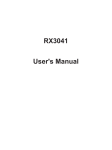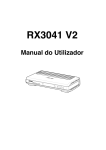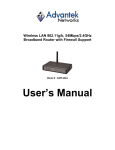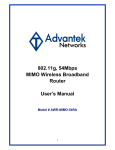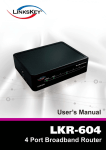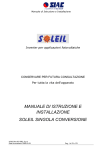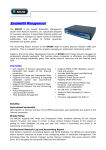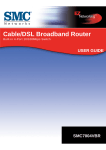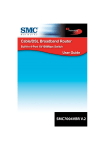Download Asus RX3041 V2 User`s manual
Transcript
RX3041 V2 User’s Manual E5315 First Edition V1 January 2010 Copyright © 2010 ASUSTeK Computer Inc. All Rights Reserved. No part of this manual, including the products and software described in it, may be reproduced, transmitted, transcribed, stored in a retrieval system, or translated into any language in any form or by any means, except documentation kept by the purchaser for backup purposes, without the express written permission of ASUSTeK Computer Inc. (“ASUS”). Product warranty or service will not be extended if: (1) the product is repaired, modified or altered, unless such repair, modification of alteration is authorized in writing by ASUS; or (2) the serial number of the product is defaced or missing. ASUS PROVIDES THIS MANUAL “AS IS” WITHOUT WARRANTY OF ANY KIND, EITHER EXPRESS OR IMPLIED, INCLUDING BUT NOT LIMITED TO THE IMPLIED WARRANTIES OR CONDITIONS OF MERCHANTABILITY OR FITNESS FOR A PARTICULAR PURPOSE. IN NO EVENT SHALL ASUS, ITS DIRECTORS, OFFICERS, EMPLOYEES OR AGENTS BE LIABLE FOR ANY INDIRECT, SPECIAL, INCIDENTAL, OR CONSEQUENTIAL DAMAGES (INCLUDING DAMAGES FOR LOSS OF PROFITS, LOSS OF BUSINESS, LOSS OF USE OR DATA, INTERRUPTION OF BUSINESS AND THE LIKE), EVEN IF ASUS HAS BEEN ADVISED OF THE POSSIBILITY OF SUCH DAMAGES ARISING FROM ANY DEFECT OR ERROR IN THIS MANUAL OR PRODUCT. SPECIFICATIONS AND INFORMATION CONTAINED IN THIS MANUAL ARE FURNISHED FOR INFORMATIONAL USE ONLY, AND ARE SUBJECT TO CHANGE AT ANY TIME WITHOUT NOTICE, AND SHOULD NOT BE CONSTRUED AS A COMMITMENT BY ASUS. ASUS ASSUMES NO RESPONSIBILITY OR LIABILITY FOR ANY ERRORS OR INACCURACIES THAT MAY APPEAR IN THIS MANUAL, INCLUDING THE PRODUCTS AND SOFTWARE DESCRIBED IN IT. Products and corporate names appearing in this manual may or may not be registered trademarks or copyrights of their respective companies, and are used only for identification or explanation and to the owners’ benefit, without intent to infringe. RX3041 V2 Router User’s Manual Contents Chapter 1: Introduction 1.1 Features and Benefits............................................................................................ 3 1.2 Package Contents................................................................................................ 3 Chapter 2: Setup Router Configurations via Web Browser 2.1 Start your Web Browser......................................................................................... 4 2.2 Wizard..................................................................................................................... 5 2.2.1 Dynamic IP Address ..............................................................................................................6 2.2.2 Static IP Address.....................................................................................................................7 2.2.3 PPPoE.......................................................................................................................................9 2.2.4 PPTP........................................................................................................................................11 2.2.5 L2TP.........................................................................................................................................12 2.2.6 BigPond..................................................................................................................................14 2.3 System.................................................................................................................. 16 2.3.1 System Status.........................................................................................................................16 2.3.2 System Settings......................................................................................................................17 2.3.3 Administrator Settings...........................................................................................................18 2.3.4 Firmware Upgrade...............................................................................................................19 2.3.5 Configuration Tools...............................................................................................................19 2.3.6 Log..........................................................................................................................................20 2.4 WAN...................................................................................................................... 21 2.4.1 Connected Type..................................................................................................................21 2.4.2 Dynamic IP address..............................................................................................................22 2.4.3 Static IP address....................................................................................................................23 2.4.4 PPPoE.....................................................................................................................................24 2.4.5 PPTP........................................................................................................................................25 2.4.6 L2TP.........................................................................................................................................26 2.4.7 BigPond..................................................................................................................................27 2.4.8 DNS.........................................................................................................................................28 2.5 LAN........................................................................................................................ 29 2.5.1 Settings...................................................................................................................................29 2.5.2 DHCP Client...........................................................................................................................30 2.6 NAT........................................................................................................................ 31 2.6.1 Virtual Server.........................................................................................................................31 2.6.2 Special Application..............................................................................................................32 2.6.3 Port Mapping........................................................................................................................33 2.6.4 ALG........................................................................................................................................33 2.6.5 DMZ........................................................................................................................................34 2.7 Firewall.................................................................................................................. 35 2.7.1 Option....................................................................................................................................35 2.7.2 Access Control......................................................................................................................36 2.7.3 URL Filtering............................................................................................................................37 2.7.4 MAC Control.........................................................................................................................37 RX3041 V2 Router User’s Manual Contents 2.8 Routing.................................................................................................................. 38 2.8.1 Routing Table........................................................................................................................38 2.8.2 Static Routes.........................................................................................................................38 2.8.3 Dynamic Routing..................................................................................................................39 2.9 UPnP...................................................................................................................... 40 2.9.1 Settings . ................................................................................................................................40 2.9.2 Port Mapping........................................................................................................................40 2.10 QoS .................................................................................................................... 41 2.10.1 Port Base..............................................................................................................................41 2.10.2 DSCP....................................................................................................................................42 2.11 DDNS................................................................................................................... 43 2.12 Help Information................................................................................................ 43 2.13 Log out................................................................................................................ 44 RX3041 V2 Router User’s Manual Chapter 1: Introduction Congratulations on purchasing ASUS RX3041 V2 Router. This router, is a high quality and reliable Internet routing device, enables multiple users to share the internet connection through a Cable or DSL modem. Simply install the router, connect to Cable/DSL modem, and surf Internet without extra efforts. Acting as a 10/100Mbps 4-port Ethernet switch as well, the router, with all ports supporting MDI/MDIX, allows you to use CAT5 cable to uplink to other routers/switches. The router provides a total solution for the Small and Medium-sized Business (SMB) and the Small Office/Home Office (SOHO) markets, giving you an instant network today, and the flexibility to handle tomorrow’s expansion and speed. 1.1 Features and Benefits • 3-step easy setup wizard All users can easily setup the router via only 3-step wizard to share internet. • User friendly Web Graphical Interface ASUS specific and user friendly interface allows users to easily set up the router. • DHCP server support This feature provides a dynamic IP address to PCs and other devices upon request. The router can act as a DHCP server for devices on your LAN. • Multi DMZ host support One PC on you LAN can be configured to allow unrestricted 2-way communication with Servers or individual user on the Internet. • Support PPTP and PPPoE The Internet (WAN port) connection supports PPPoE (PPP over Ethernet) and PPTP (Point-to-Point Tunnel Protocol), as well as “Direct Connection” type service. 1.2 Package Contents • One RX3041 V2 Router • Power Adapter • CD including user manual • QIG RX3041 V2 Router User’s Manual Chapter 2: Setup Router Configurations via Web Browser The router comes with a web-based configuration utility. Users can access this configuration utility from any of client system within RX3041 V2 Router’s LAN. For best results, either use Microsoft Internet Explorer 6.0 or later, or Netscape Navigator 4.7 or later. Before you start configuring your router, you have to get the following information from your ISP: a) Has your ISP assigned you a static IP address, or they will assign one to you dynamically? If you have received a static IP address, what is it? b) Does your ISP use PPPoE? If so, what is your PPPoE username and password? If you are not sure of above questions, please contact your ISP. 2.1 Start your Web Browser To use the Web-Based Utility, you have to launch your Internet Browser (MS IE 6.0 or later, Netscape Navigator 4.7 or later). Step1: Enter the default IP address of RX3041 V2 Router http://192.168.1.1 in the address field, and then, press Enter button: Step2: After the login dialog box appears, enter “admin” as User Name and the default password is also “admin”, and then click “OK” to login web-based utility. RX3041 V2 Router User’s Manual 2.2 Wizard The following window allows user to configure basic settings of the router, such as Host Name, Domain Name, Time Zone and Daylight Saving. Click “Next” to update WAN settings. Host Name: Enter a hostname provided by the ISP (Default: RX3041 V2). Domain Name: Enter a Domain Name provided by the ISP. Time Zone: Select the time zone of the country you are in. The router will set the time based on your selection. Daylight Saving: The router can also take Daylight savings into account. If you wish to use this function, you must check/tick the enable box to enable your daylight saving configuration. Next: Click “Next” to update WAN settings. The following window allows user to specify the WAN Connection type, such as Dynamic IP address, Static IP address, or PPPoE...etc. After you setup the connection settings, click “Next” to update the DNS settings. RX3041 V2 Router User’s Manual 2.2.1 Dynamic IP Address Obtain an IP address automatically from your service provider. Step 1: Select “Dynamic IP address” from WAN connection type. Step 2: Enable “MAC Cloning” and enter “MAC address”. You can also click “Clone MAC” button to copy the MAC address of the Ethernet Card installed by your ISP and replace the WAN MAC address with this MAC address. Click “Next” to continue. Step 3: Enable DNS Settings if required, enter the DNS server address(es). Click “Finish” to save the settings. RX3041 V2 Router User’s Manual Step 4: After Wizard setting is completed, the configuration page will show Success. Step 5: You can use the “Status” screen to see the Dynamic IP connection status. 2.2.2 Static IP Address If your router connects to the Fixed-IP xDSL, click Static IP address to enter the IP address and gateway address provided by your ISP. Step 1: Select “Static IP address” from WAN connection type. RX3041 V2 Router User’s Manual Step 2: Enter Static IP address which assigned by your ISP. Click “Next” to continue. Step 3: Enable DNS Settings if required, enter the DNS server address(es). Click “Finish” to save the settings. Step 4: After Wizard setting is completed, the configuration page will show Success. RX3041 V2 Router User’s Manual Step 5: You can use the “Status” screen to see the Static IP address connection status. 2.2.3 PPPoE If your router connects to the Dial-Up xDSL, click Dial-Up xDSL to enter the login information provided by your ISP. Step 1: Select “PPPoE” from WAN connection type. Step 2: Enter PPPoE Account and Password which provided by your ISP. Click “Next” to continue. RX3041 V2 Router User’s Manual Step 3: Enable DNS Settings if required, enter the DNS server address(es). Click “Finish” to save the settings. Step 4: After Wizard setting is completed, the configuration page will show Success. Step 5: You can use the “Status” screen to see the PPPoE connection status. 10 RX3041 V2 Router User’s Manual 2.2.4 PPTP If your router connects through the PPTP, click PPTP to enter the login information provided by your ISP. Step 1: Select “PPTP” from WAN connection type. Step 2: Enter PPTP Account, Password, Service IP address, WAN IP address, Subnet address, Gateway which provided by your ISP. Click “Next” to continue. Step 3: Enable DNS Settings if required, enter the DNS server address(es). Click “Finish” to save the settings. 11 RX3041 V2 Router User’s Manual Step 4: After Wizard setting is completed, the configuration page will show Success. Step 5: You can use the “Status” screen to see the PPTP connection status. 2.2.5 L2TP If your router connects through the L2TP, click L2TP to enter the login information provided by your ISP. Step 1: Select “L2TP” from WAN connection type. 12 RX3041 V2 Router User’s Manual Step 2: Enter L2TP Account, Password, Service IP address, WAN IP address, Subnet address, Gateway which provided by your ISP. Click “Next” to continue. Step 3: Enable DNS Settings if required, enter the DNS server address(es). Click “Finish” to save the settings. Step 4: After Wizard setting is completed, the configuration page will show Success. 13 RX3041 V2 Router User’s Manual Step 5: You can use the “Status” screen to see the PPTP connection status. 2.2.6 BigPond This connection is only for Telstra BigPond (Australia) Server use. Step 1: Select “BigPond” from WAN connection type. Step 2: Enter BigPond Account, Password, and Authentication Server which provided by local ISP. Click “Next” to continue. 14 RX3041 V2 Router User’s Manual Step 3: Enable DNS Settings if required, enter the DNS server address(es). Click “Finish” to save the settings. Step 4: After Wizard setting is completed, the configuration page will show Success. Step 5: You can use the “Status” screen to see the BigPond connection status. 15 RX3041 V2 Router User’s Manual 2.3 System This section displays the basic configuration parameters of your router, such as System Status, System Settings, Administrator Settings, Firmware Upgrade, Configuration Tools and System Log. Although most users will be able to accept the default settings, every ISP is different. Please check with your ISP if you are not sure which settings the ISP requires. 2.3.1 System Status You can use the Status screen to see the connection status for the router’s LAN interfaces, firmware and hardware version numbers, and the number of connected clients to your network. INTERNET: Displays WAN connection type and status. GATEWAY: Displays system IP settings, as well as DHCP, NAT and Firewall status. INFORMATION: Displays the number of connected clients, as well as the router’s hardware and firmware version numbers. 16 RX3041 V2 Router User’s Manual 2.3.2 System Settings The System Settings window configures the router’s basic settings, such as the router’s Host Name, Domain Name, Set Time Zone, Daylight Saving and NAT. Host Name: Enter a hostname provided by the ISP (Default: RX3041 V2). Domain Name: Enter a Domain Name provided by the ISP . Set Time Zone: Select the time zone of the country you are currently in. The router will set the time based on your selection. Daylight Saving: The router can also take Daylight savings into account. If you wish to use this function, you must check/tick the enable box to enable your daylight saving configuration. NAT: You can select to enable NAT function. 17 RX3041 V2 Router User’s Manual 2.3.3 Administrator Settings Use this menu to restrict management access based on a specific password. By default, the password is admin. So please assign a password to the Administrator as soon as possible, and save it in a safe place. Passwords can contain from 3-12 alphanumeric characters, and are case sensitive. Administrator Time-Out - The amount of time of inactivity before the router will automatically close the Administrator session. Set this to zero to disable it. Remote Management - By default, management access is only available to users on your local network. However, you can also manage the router from a remote host by adding the IP address of an administrator to this screen. Password Settings: Allows you to select a password in order to access the web-based management website Remote Management: Defined special IP for remote management. You should enter the IP here (note: ISP provides more than one IP address, you should enable “Does ISP provide more IP address?”, and the IP address should match with remote management IP. Port: Enter the remote management port. 18 RX3041 V2 Router User’s Manual 2.3.4 Firmware Upgrade User uses the Firmware Upgrade window to locate the new firmware then upgrade the system firmware. Click Browse to search for the new firmware location, and then click OK to process the upgrade. Firmware Upgrade: This tool allows you to upgrade the router’s system firmware. To upgrade the firmware of your router, you need to download the firmware file to your local hard disk, use the Browse button to find the firmware file on your PC. 2.3.5 Configuration Tools Use this window to restore or backup RX3041 V2 router settings, such as Restart System, Restore Factory Default, Backup Settings and Restore Settings. Restart System: Reboot this device. Restore Factory Default: Reset the settings of this device to the factory default values. Backup Settings: Save the settings of this device to a file. Restore Settings: Restore the settings of this device to the backup settings. 19 RX3041 V2 Router User’s Manual 2.3.6 Log The System Log window displays the router’s system activities and configures remote log settings. Not only does the device display the logs of activities and events, it can be setup to send these logs to another location. The logs can be sent via email to a specific email account. System Log: The router’s system activity. Remote Log: Enable this option for sending log to remote log server. Send log to: Enter the destination IP of remote log server. Email Log: Enable this option and the logs will send to the specific email address. Send Email to: Enter the email address which the Email address the logs will be sent to. SMTP server: Enter the address of the SMTP (Simple Mail Transfer Protocol) server that will be used to send the logs. 20 RX3041 V2 Router User’s Manual 2.4 WAN 2.4.1 Connected Type Specify the WAN connection type required by your Internet Service Provider, then click “OK” button to provide detailed configuration parameters for the selected connection type. Dynamic IP address: You will obtain an IP address from your ISP automatically. Static IP address: you can use the fixed IP address assigned by your ISP to access the internet service. PPPoE: PPPoE is a common connection type used for xDSL. PPTP: PPP Tunneling Protocol can support multi-protocol Virtual Private Network (VPN) L2TP: Layer 2 Tunneling Protocol can support multi-protocol Virtual Private Network (VPN) BigPond: BigPond is an Australian internet service provider and is a subsidiary of Telstra. 21 RX3041 V2 Router User’s Manual 2.4.2 Dynamic IP address The Host Name is optional, but may be required by some ISPs. The default MAC address is set to the WAN’s physical interface on the router. Use this address when registering for Internet service, and do not change it unless it is required by your ISP, You can use the “Clone MAC Address” button to copy the MAC address of the Ethernet Card installed by your ISP and replace the WAN MAC address with this MAC address. Request IP address: Enter the IP address of the device which you will clone. MTU: This is optional. You can specify the maximum size of the packets transmitted to the Internet. Leave it as it is if you do not wish to set a maximum packet size. MAC Cloning: Enable or disable MAC cloning option. MAC Address: Enter the MAC address of the device you want to clone. 22 RX3041 V2 Router User’s Manual 2.4.3 Static IP address If your Internet Service Provider has assigned a fixed address, enter the assigned address and subnet mask for the router, then enter the gateway address of your ISP. IP address assigned by your ISP: The IP address is provided by your ISP. Subnet Mask: Enter the subnet mask of the router. ISP Gateway Address: Enter the gateway address at ISP end. MTU: This is optional. You can specify the maximum size of the packets transmitted to the internet. Leave it as it is if you to not wish to set a maximum packet size. MAC Cloning: MAC address of WAN. If you use cable modem you must input it. You can use the Clone MAC Address button to copy the MAC address of the Ethernet Card installed by your ISP and replace the WNA MAC address with this MAC address. Does ISP provide more IP addresses: If your ISP supports more IP addresses, please click Yes; otherwise, leave it unchecked. 23 RX3041 V2 Router User’s Manual 2.4.4 PPPoE Enter the PPPoE user name and password assigned by your Service Provider. The Service Name is normally optional, and may be required by some service providers. Enter a Maximum Idle Time (in minutes) to define a maximum period of time for which the Internet connection is maintained when it is inactive. If the connection is inactive for longer than the defined Maximum Idle Time, then it will be dropped. You can enable the Auto-reconnect option to automatically reestablish the connection as soon as you attempt to access the Internet again. User Name: Enter the username provided by the ISP. Password: Enter the password provided by the ISP. Retype Password: Retype the password for confirmation purposes. Service Name: This is optional. Enter the Service name provided that your ISP requires it, otherwise leave it blank. MTU: This is optional. You can specify the maximum size of the packets transmitted to the Internet. Leave it as it is if you do not wish to set a maximum packet size. Maximum Idle Time: You can specify an idle time threshold (minutes) for the WAN port. This means if no packet has been sent (no one using the Internet) during this specified period, the router will automatically end the connection with your ISP. Connection Mode: To select the PPPoE connection mode, it includes Keep-alive, auto-connect and manual-on. 24 RX3041 V2 Router User’s Manual 2.4.5 PPTP The PPTP window allows user to configure basic PPTP settings for the router. PPTP Account: Enter the PPTP Account provided by the ISP. PPTP Password: Enter the password provided by the ISP. Retype Password: Retype the password for confirmation purposes. PPTP Gateway: If your LAN has a PPTP gateway, then enter that PPTP gateway IP address here. If you do not have a PPTP gateway, then enter the ISP’s Gateway IP address above. IP Address: This is the IP address provided by your ISP to establish a PPTP connection. Connection ID: This is an optional ID given by the ISP. MTU: This is optional. You can specify the maximum size of the packets transmitted to the Internet. Leave it as it is if you do not wish to set a maximum packet size. Maximum Idle Time: You can specify an idle time threshold (minutes) for the WAN port. This means if no packet has been sent (no one using the Internet) during this specified period, the router will automatically end its connection with your ISP. Connection Mode: Select the connection mode PPTP uses, it includes Keep-alive, auto-connect and manual-on. MPPE: To enable or disable Microsoft Point-to-Point Encryption mode. 25 RX3041 V2 Router User’s Manual 2.4.6 L2TP The L2TP window allows user to configure basic L2TP settings for the router. L2TP Account: Enter the L2TP Account provided by the ISP. L2TP Password: Enter the password provided by the ISP. Retype Password: Retype the password for confirmation purposes. L2TP Gateway: If your LAN has a L2TP gateway, then enter that L2TP gateway IP address here. If you do not have a L2TP gateway then enter the ISP’s Gateway IP address. IP Address: This is the IP address provided by your ISP to establish a L2TP connection. MTU: This is optional. You can specify the maximum size of the packets transmitted to the Internet. Leave it as it is if you do not wish to set a maximum packet size. Maximum Idle Time: You can specify an idle time threshold (minutes) for the WAN port. This means if no packet has been sent (no one using the Internet) during this specified period, the router will automatically end its connection with your ISP. Connection Mode: To select L2TP connection mode, it includes keep-alive, autoconnect and manual-on. 26 RX3041 V2 Router User’s Manual 2.4.7 BigPond BigPond is an Australian internet service provider and is a subsidiary of Telstra. User Name: Enter the username provided by the Australian ISP. Password: Enter the password provided by the Australian ISP. Please retype your Password: Retype the password for confirmation purposes. Authentication Service: Enter the Service name provided that your ISP requires it, otherwise leave it blank. Request IP address: Enter the IP address of the device which you will clone. MTU: This is optional. You can specify the maximum size of the packets transmitted to the Internet. Leave it as it is if you do not wish to set a maximum packet size. MAC Cloning: Enable or disable MAC cloning option. MAC Address: Enter the MAC address of the device you want to clone. 27 RX3041 V2 Router User’s Manual 2.4.8 DNS Domain Name Servers are used to map an IP address to the equivalent domain name (e.g.www.waveplus.com). Your ISP should provide the IP address for one or more domain name servers. Domain Name Server (DNS) Address: This is the IP address of the DNS server provided by the ISP; or you can specify your own preferred DNS server IP address. Secondary DNS Address (optional): This is optional. You can enter another IP address of the DNS server as a backup. The secondary DNS will be used when the above DNS fails. 28 RX3041 V2 Router User’s Manual 2.5 LAN 2.5.1 Settings Configure the gateway address of the router. To dynamically assign the IP address for clients’ PCs, enable the DHCP Server, set the lease time, and then specify the address range. Valid IP addresses consist of four numbers, which are separated by periods. The first three fields are the network portion ranging from 0 to 255, while the last field is the host portion ranging from 1 to 254. IP address: This is the router’s LAN port IP address (Your LAN clients’ default gateway IP address) Subnet Mask: Specify a Subnet Mask for your LAN segment. The Gateway acts as DHCP Server: You can enable or disable the DHCP server. IP Pool Starting Address: Enter the first address assigned by the DHCP server. IP Pool Ending Address: Enter the last address assigned by the DHCP server. Lease Time: Enter the number of hours that a client can use the assigned IP address. DNS Proxy: To enable or disable DNS Proxy. 29 RX3041 V2 Router User’s Manual 2.5.2 DHCP Client The DHCP client list allows you to see which clients are connected to the router via IP address, host name, and MAC address. DHCP Client List: This page shows all DHCP clients (LAN PCs) currently connected to your network. It displays the IP address and the MAC address and Remaining Time of each LAN client. Use the Refresh button to get the lately updated situation 30 RX3041 V2 Router User’s Manual 2.6 NAT 2.6.1 Virtual Server If you configure the router as a virtual server, remote users access services such as Web or FTP at your local site via public IP addresses can be automatically redirected to local servers configured with private IP address. In other words, depending on the requested service (TCP/UDP port number), the router redirects the external service request to the appropriate server. Example: ID Private IP Private Port Type Public Port Comment 1 192.168.1.20 200 TCP 80 Web Server 2 192.168.1.12 333 TCP 21 FTP Server 3 192.168.1.28 455 TCP 23 Telnet Server Private IP: This is the LAN client/host IP address to which the Public Port number packet will be sent. Private Port: This is the port number (of the above Private IP host) to which the Public Port number below will be changed when the packet enters your LAN (to the LAN Server/Client IP) Type: Select the port number protocol type (TCP, UDP or both). If you are not sure, leave it to be the default TCP protocol. Public Port: Enter the service (service/Internet application) port number that will be re-directed to the above Private IP address host in your LAN. Comment: The description of this setting. Enabled: Enable the Virtual Server function. 31 RX3041 V2 Router User’s Manual 2.6.2 Special Application Some applications require multiple connections, such as Internet gaming, video conferencing, Internet telephony and others. These applications cannot work when Network Address Translation (NAT) is enabled. If you need to run applications that require multiple connections, specify the port associated with an application in the “Trigger Port” out going port field, select the protocol type as TCP or UDP, then enter the public ports incoming port associated with the trigger port to open them for inbound traffic. Example: ID Trigger Port Trigger Type Public Port Public Type Comment 1 47624 UDP 2300-2400, 28800-29000 UDP MSN Game Zone 2 47624 UDP 2300-2400, 28800-29000 TCP MSN Game Zone 3 61112 UDP 6112 UDP Battle.net Trigger Port: This is the outgoing (Outbound) range of port numbers for this particular application. Trigger Type: Select the type of outbound port protocol; it may be “TCP”, “UDP” or “Both”. Public Port: Enter the Incoming (Inbound) port or port range for this type of application (e.g. 2300-2400, 47624) Public Type: Select the type of In-bound port protocol: “TCP”, “UDP” or “Both”. Comment: The description of this setting. Enable: Enable the Special Application function. 32 RX3041 V2 Router User’s Manual 2.6.3 Port Mapping This function allows one or more public IP addresses to be shared by multiple internal users. Enter the Public IP address you desire to share into the Global IP field. Enter a range of internal IP that will share the global IP. Server IP: Enter the NAT server IP address. Mapping Ports: Enter the port number to which the NAT server maps. Type: Select the type of the In-bound port protocol: “TCP”, “UDP” or “Both” Comment: The description of this setting. Enabled: Enable the Port Mapping function. 2.6.4 ALG The ALG (Application Layer Gateway) window allows users to configure ALG settings for the router. ALG (Application Layer Gateway): You can choose to enable ALG, and then the router will let that application correctly pass though the NAT gateway. 33 RX3041 V2 Router User’s Manual 2.6.5 DMZ If you have a client PC that cannot run Internet application properly from behind the NAT firewall or after configuring the Special Applications function, then you can open the client up to unrestricted two-way Internet access. Enter the IP address of a DMZ host to this screen. Adding a client to the DMZ (Demilitarized Zone) may expose your local network to a variety of security risks, so you can only use this option as a last resort. DMZ (Demilitarized Zone): Enable/disable DMZ. Public IP Address: The IP address of the WAN port or any other Public IP addresses provided by your ISP. IP Address of Virtual DMZ Host: Enter the DMZ host IP address. 34 RX3041 V2 Router User’s Manual 2.7 Firewall 2.7.1 Option The router provides extensive firewall protection by restricting connections to reduce the risk of intrusion and defending against a wide array of common hacker attacks. However, for applications that require unrestricted access to the Internet, you can configure a specific client/server as a demilitarized zone (DMZ). Firewall Options: Select the functions that firewall supports. The selections include Enable Hacker Attack Protect, Discard PING from WAN side, Deny PING to the Gateway, Drop Port Scan packets, Allow to Scan Security Port (113), Discard NetBios Packets, Accept Fragment Packets and Send ICMP Packets When Error is Encountered. 35 RX3041 V2 Router User’s Manual 2.7.2 Access Control You can filter Internet access for local clients based on IP addresses, port, application types, (i.e., HTTP port), and time of day. For example, this screen shows that clients in the address range 192.168.1.50-99 are permanently restricted from using FTP (Port 21), while clients in the address range 192.168.1.110-119 are blocked from browsing the Internet from Monday through Friday. 36 RX3041 V2 Router User’s Manual 2.7.3 URL Filtering To configure the URL Filtering feature, please specify the web sites (www.somesite. com) and/or web URLs containing the keyword you want to filter on your network. 2.7.4 MAC Control The MAC Control window allows user to block certain client PCs’ access to the Internet based on MAC address. MAC Address Control: This function allows user to determine whether to filter out or accept the following MAC address that attempts to connect to the internet. Configure MAC Filter: Enter the MAC address to filter out or to accept. 37 RX3041 V2 Router User’s Manual 2.8 Routing 2.8.1 Routing Table The Routing Table window displays the current routing information in the system. 2.8.2 Static Routes A static route is a pre-determined pathway that network information must travel toreach a specific host or network. Destination LAN IP: The network address of destination network. Subnet Mask: The subnet mask of destination network. Gateway: The next stop gateway of the path toward the destination network. This is the IP of the neighbor router that this router should communicate with on the path to the destination network. 38 RX3041 V2 Router User’s Manual 2.8.3 Dynamic Routing Dynamic Routing can be used to cache routes learned by routing protocols, thus allowing the automation of static routing maintenance. The router, using the RIP (Routing Information Protocol), determines the network packet’s route based on the fewest number of hops between the source and the destination. In this case, you can automatically adjust to physical changes in the network layout. Working Mode: Select the router acts as router or gateway. Listen Mode: Enable this mode to allow RIP server to receive routing information and update the routing information. Supply Mode: Enable this mode to allow RIP server to send out routing information and update the routing information. 39 RX3041 V2 Router User’s Manual 2.9 UPnP 2.9.1 Settings UPnP (Universal Plug and Play) allows automatic discovery and configuration of equipment attached to your LAN. UPnP is supported by Windows ME, XP, or later. It provides compatibility with networking equipment, software and peripherals of over 400 vendors that cooperate in the Plug And Play forum. UPnP Settings: You can Enable or Disable UPnP feature here. 2.9.2 Port Mapping The Port Mappings window displays all UPnP ports mapping information. 40 RX3041 V2 Router User’s Manual 2.10 QoS QoS (Quality of Service). This option will provide better service of selected network traffic over various technologies. Deploying QoS management to guarantee that all application receive the service levels required and sufficient bandwidth to meet performance expectations is indeed one important aspect of modem enterprise network. 2.10.1 Port Base Port Base feature is the solution for managing and avoiding congestion where the network meets limited broadband bandwidth. The network traffic can be set maximum rate limits by per-port. You can control bandwidth according to which of the physical LAN ports and WAN port of your computer or device is plugged into. Enable Port Rate Control: Make the check mark to enable Port Base function. LAN-1 ~4 / WAN: Key in the rate value from 1 ~ 100000 (Default is 0). QoS’ Port base feature let you assign a High or Low traffic (data) priority to LANs and WAN port. You can enable Port rate control and set an ingress rate limit of Tx/Rx bandwidth traffic. 41 RX3041 V2 Router User’s Manual 2.10.2 DSCP DSCP (Differentiated Services Code Point) means the traffic classification based on the packet’s IP precedence making. (To manages and avoid traffic congestion by defining inbound and outbound priority rules for each device on the Router). These rules determine the priority that packets, traveling through the device, will receive. You can set the queue weight value to arrange the traffic usage, and decide which DSCP value will use the corresponding queue. After checked Enable DSCP, more settings will be explored. High queue weight: Set weight value for the highest priority. Medium queue weight: Set weight value for the medium priority. Low queue weight: Set weight value for the lowest priority. For High queue, Medium queue, and Low queues, setting different weight for them are to assign different throughput for these priorities. The default values are: High queue: Medium queue: Low queue = 8 : 4 : 2 That means High queue’s throughput should be double of Medium queue and quadruple of Low queue. You can change the weight by your need. Of course, you should not assign the bigger weight value for lower priorities. That are illegal input and error message will alert. Enable Rule: Check to active the rule and verse versa. DSCP value: Set the DSCP for this rule. Range of this number is from 0 to 63. Queue map: Map a High, Medium or Low queue to this DSCP value. Description: Text field to enter the name or notes for this rule. Rules Listing: After rules are added, it will be listed in this table. 42 RX3041 V2 Router User’s Manual 2.11 DDNS DDNS (Dynamic DNS) provides you on the Internet with a method to tie their domain name to a computer or server. DDNS allows your domain name to follow your IP address automatically by changing your DNS records when your IP address changes. DDNS: Enable/Disable the DDNS function of this router. 2.12 Help Information The help information displays on the right side of some screens. All the router functions are described and some technical terms are listed in the help information. 43 RX3041 V2 Router User’s Manual 2.13 Log out Click Logout in the task bar to initiate the router logout process. Click OK to logout the router utility. 44














































